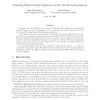Free Online Productivity Tools
i2Speak
i2Symbol
i2OCR
iTex2Img
iWeb2Print
iWeb2Shot
i2Type
iPdf2Split
iPdf2Merge
i2Bopomofo
i2Arabic
i2Style
i2Image
i2PDF
iLatex2Rtf
Sci2ools
97
Voted
EUROCRYPT
2009
Springer
2009
Springer
Realizing Hash-and-Sign Signatures under Standard Assumptions
Currently, there are relatively few instances of "hash-and-sign" signatures in the standard model. Moreover, most current instances rely on strong and less studied assumptions such as the Strong RSA and q-Strong Diffie-Hellman assumptions. In this paper, we present a new approach for realizing hash-and-sign signatures in the standard model. In our approach, a signer associates each signature with an index i that represents how many signatures that signer has issued up to that point. Then, to make use of this association, we create simple and efficient techniques that restrict an adversary which makes q signature requests to forge on an index no greater than 2 lg(q) < 2q. Finally, we develop methods for dealing with this restricted adversary. Our approach requires that the signer maintain a small amount of state -- a counter of the number of signatures issued. We achieve two new realizations for hash-and-sign signatures respectively based on the RSA assumption and the Comp...
Computational Diffie-Hellman Assumption | Cryptography | EUROCRYPT 2009 | Hash-and-sign Signatures | Q-strong Diffie-hellman Assumptions |
Related Content
| Added | 24 Nov 2009 |
| Updated | 24 Nov 2009 |
| Type | Conference |
| Year | 2009 |
| Where | EUROCRYPT |
| Authors | Susan Hohenberger, Brent Waters |
Comments (0)

